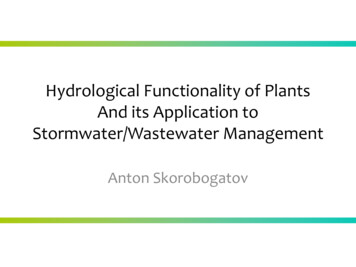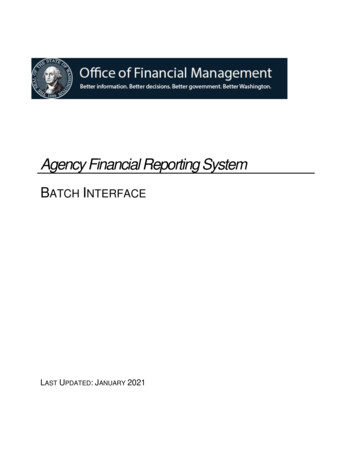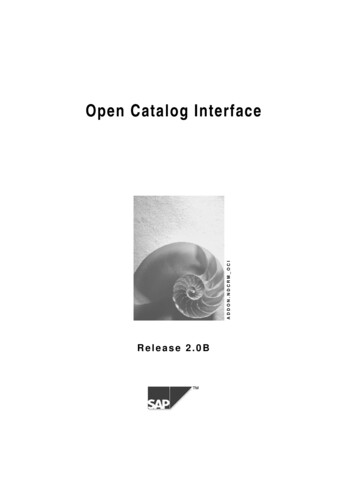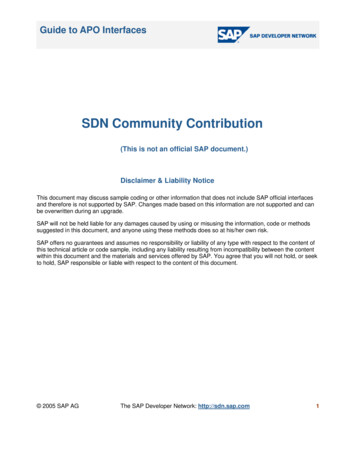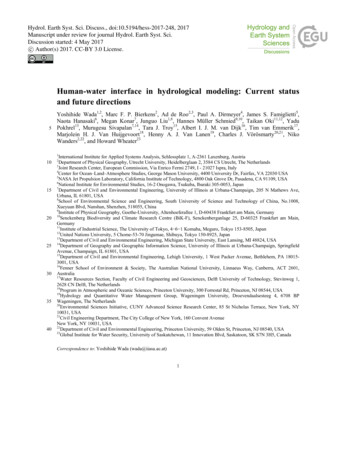
Transcription
Hydrol. Earth Syst. Sci. Discuss., doi:10.5194/hess-2017-248, 2017Manuscript under review for journal Hydrol. Earth Syst. Sci.Discussion started: 4 May 2017c Author(s) 2017. CC-BY 3.0 License.Human-water interface in hydrological modeling: Current statusand future directionsYoshihide Wada1,2, Marc F. P. Bierkens2, Ad de Roo2,3, Paul A. Dirmeyer4, James S. Famiglietti5,Naota Hanasaki6, Megan Konar7, Junguo Liu1,8, Hannes Müller Schmied9,10, Taikan Oki11,12, Yadu137,141516175 Pokhrel , Murugesu Sivapalan , Tara J. Troy , Albert I. J. M. van Dijk , Tim van Emmerik ,181920,21Marjolein H. J. Van Huijgevoort , Henny A. J. Van Lanen , Charles J. Vörösmarty, NikoWanders2,22, and Howard Wheater23110152025303540International Institute for Applied Systems Analysis, Schlossplatz 1, A-2361 Laxenburg, AustriaDepartment of Physical Geography, Utrecht University, Heidelberglaan 2, 3584 CS Utrecht, The NetherlandsJoint Research Center, European Commission, Via Enrico Fermi 2749, I - 21027 Ispra, Italy4Center for Ocean–Land–Atmosphere Studies, George Mason University, 4400 University Dr, Fairfax, VA 22030 USA5NASA Jet Propulsion Laboratory, California Institute of Technology, 4800 Oak Grove Dr, Pasadena, CA 91109, USA6National Institute for Environmental Studies, 16-2 Onogawa, Tsukuba, Ibaraki 305-0053, Japan7Department of Civil and Environmental Engineering, University of Illinois at Urbana-Champaign, 205 N Mathews Ave,Urbana, IL 61801, USA8School of Environmental Science and Engineering, South University of Science and Technology of China, No.1008,Xueyuan Blvd, Nanshan, Shenzhen, 518055, China9Institute of Physical Geography, Goethe-University, Altenhoeferallee 1, D-60438 Frankfurt am Main, Germany10Senckenberg Biodiversity and Climate Research Centre (BiK-F), Senckenberganlage 25, D-60325 Frankfurt am Main,Germany11Institute of Industrial Science, The University of Tokyo, 4 6 1 Komaba, Meguro, Tokyo 153-8505, Japan12United Nations University, 5 Chome-53-70 Jingumae, Shibuya, Tokyo 150-8925, Japan13Department of Civil and Environmental Engineering, Michigan State University, East Lansing, MI 48824, USA14Department of Geography and Geographic Information Science, University of Illinois at Urbana-Champaign, SpringfieldAvenue, Champaign, IL 61801, USA15Department of Civil and Environmental Engineering, Lehigh University, 1 West Packer Avenue, Bethlehem, PA 180153001, USA16Fenner School of Environment & Society, The Australian National University, Linnaeus Way, Canberra, ACT 2601,Australia17Water Resources Section, Faculty of Civil Engineering and Geosciences, Delft University of Technology, Stevinweg 1,2628 CN Delft, The Netherlands18Program in Atmospheric and Oceanic Sciences, Princeton University, 300 Forrestal Rd, Princeton, NJ 08544, USA19Hydrology and Quantitative Water Management Group, Wageningen University, Droevendaalsesteeg 4, 6708 BPWageningen, The Netherlands20Environmental Sciences Initiative, CUNY Advanced Science Research Center, 85 St Nicholas Terrace, New York, NY10031, USA21Civil Engineering Department, The City College of New York, 160 Convent AvenueNew York, NY 10031, USA22Department of Civil and Environmental Engineering, Princeton University, 59 Olden St, Princeton, NJ 08540, USA23Global Institute for Water Security, University of Saskatchewan, 11 Innovation Blvd, Saskatoon, SK S7N 3H5, Canada23Correspondence to: Yoshihide Wada (wada@iiasa.ac.at)1
Hydrol. Earth Syst. Sci. Discuss., doi:10.5194/hess-2017-248, 2017Manuscript under review for journal Hydrol. Earth Syst. Sci.Discussion started: 4 May 2017c Author(s) 2017. CC-BY 3.0 License.Abstract. Over the last decades, the global population has been rapidly increasing and human activities have alteredterrestrial water fluxes at an unprecedented scale. The phenomenal growth of the human footprint has significantly modifiedhydrological processes in various ways (e.g., irrigation, artificial dams, and water diversion) and at various scales (from awatershed to the globe). During the early 1990s, awareness of the potential water scarcity led to the first detailed global5water resource assessments. Shortly thereafter, in order to analyse the human perturbation on terrestrial water resources, thefirst generation of large-scale hydrological models (LHMs) was produced. However, at this early stage few modelsconsidered the interaction between terrestrial water fluxes and human activities, including water use and reservoir regulation,and even fewer models distinguished water use from surface water and groundwater resources. Since the early 2000s, agrowing number of LHMs are incorporating human impacts on hydrological cycle, yet human representations in10hydrological models remain challenging. In this paper we provide a synthesis of progress in the development and applicationof human impact modeling in LHMs. We highlight a number of key challenges and discuss possible improvements in orderto better represent the human-water interface in hydrological models.1 IntroductionThe Earth’s surface has undergone drastic changes due to the human-driven alteration of land use and vegetation patterns15and the management of surface water and groundwater systems (Bondeau et al., 2007; Gerten et al., 2007; Rost et al., 2008).Over the last century, the global population has quadrupled and currently exceeds 7 billion, half of which live in urban areas.The rapidly growing population and rising food demands have caused a drastic six-fold expansion of global irrigated areasduring the 20th century (Siebert et al., 2015). Human needs for water are ever-increasing, dominated currently byagricultural irrigation for food production worldwide ( 70%). However, rapid urbanization and economic development are20likely to be the main drivers for increasing water demands worldwide (Wada et al., 2016c). Humans extract vast amounts ofwater from surface water and groundwater resources (Siebert et al., 2010; Siebert and Döll, 2010; Wisser et al., 2010;Konikow, 2011), and these amounts have increased from 500 to 4000 km3 yr-1 over the last 100 years (Oki and Kanae,2006; Hoekstra and Chapagain, 2007; Hanasaki et al., 2008a,b; Wada et al., 2014). Tens of thousands of artificial dams havebeen built in major river systems with total storage capacities exceeding 8000 km3 worldwide (Nilsson et al., 2005; Lehner25et al., 2011). These are used to boost water supply, to provide flood control, and to serve as a source of hydropowergeneration to supply the energy needs for industries (Liu et al., 2015, 2016). However, regional and seasonal variations ofwater supply and demand are large, causing water scarcity in various regions of the world (Gleick, 2000, 2003; Vörösmartyet al., 2000; Oki and Kanae, 2006; Kummu et al., 2010). In such regions, groundwater is often intensively used tosupplement the excess demand, often leading to groundwater depletion (Rodell et al., 2009; Famiglietti et al., 2011;30Konikow, 2011; Gleeson et al., 2012; Scanlon et al., 2012; Taylor et al., 2013). Climate change adds further pressure on theEarth’s water resources and is likely to amplify human water demands due to increasing temperatures over agricultural lands(Dirmeyer et al., 2006, 2009, 2014; Wada et al., 2013; Haddeland et al., 2014; Schewe et al., 2014).2
Hydrol. Earth Syst. Sci. Discuss., doi:10.5194/hess-2017-248, 2017Manuscript under review for journal Hydrol. Earth Syst. Sci.Discussion started: 4 May 2017c Author(s) 2017. CC-BY 3.0 License.Terrestrial water fluxes have been affected by humans at an unprecedented scale and the fingerprints that humans have lefton the Earth’s water resources are increasingly discernible in a diverse range of records that can be seen in both surfacefreshwater and groundwater resources. The United Nations alerts us that in water scarce regions the shortage of water is5beginning to limit economic growth and create large uncertainties for the sustainability of future water supply (World WaterAssessment Programme, 2003). Given rising levels of population, wealth, and the heavy dependence of the world economyand livelihoods on water, human impacts on land and water systems are pervasive (World Water Assessment Programme,2016). Agriculture and urbanization affect the delivery of water and solutes to river and groundwater systems (Siebert et al.,2010); many river flows are regulated by dams for multiple purposes, including storage for water resources, hydropower10generation and flood risk management (Lehner et al., 2011) and maintaining ecological flows (Poff et al., 2010); water use,in particular for irrigation, can be a dominant factor in the hydrological cycle, including effects on land-atmospherefeedbacks and precipitation (Wada et al., 2016a) that can have substantial non-local impacts (Dirmeyer et al. 2009;Tuinenburg 2012; Wei et al. 2013; Lo and Famiglietti, 2013). In an era now designated as the Anthropocene (Steffan et al.,2011; Montanari et al., 2013; Savenije et al., 2014), water must therefore be considered as a coupled human-natural system.15During the early 1990s, awareness of the potential global water scarcity led to the first detailed global water resourceassessments comparing water availability with water use based on national statistics and observed climate information.Shortly thereafter, in order to analyse the human perturbation on water resources, the first generation of large-scalehydrological models (LHMs) appeared (Bierkens, 2015). These models solve the local water balance consistently across20large scales and calculate river discharge by accumulating gridded runoff over a river network constructed from topographicinformation (Vörösmarty et al., 1989). However, at this early stage few models considered the interaction between terrestrialwater fluxes and human activities, including water use and reservoir regulation, and even fewer models distinguished wateruse from surface water and groundwater resources (Nazemi and Wheater, 2015a,b). The phenomenal growth of the humanfootprint has significantly modified hydrological processes in various ways (e.g., land use, artificial dams, and water25diversion) and at various scales (from a watershed to the globe) (Sivapalan et al., 2012; Sivapalan, 2015). The increasingnumber of recent global and regional studies show that human activities can no longer be neglected in hydrological models,since otherwise the resulting assessments will be biased towards the natural conditions in many parts of the world. Since theearly 2000s, a growing number of LHMs are incorporating human impacts on the hydrological cycle; however, humanrepresentations in hydrological models are still rather simplistic.30In this paper, we review the evolution of modeling human impacts on global water resources. The paper provides a synthesisof progress in the development and application of LHMs that include an explicit treatment of human-water interactions, thelessons learned, challenges faced, and perspectives on future extensions. In this review, a number of key challenges areidentified and possible improvements are discussed. This synthesis paper is an outcome of the Symposium in Honor of Eric3
Hydrol. Earth Syst. Sci. Discuss., doi:10.5194/hess-2017-248, 2017Manuscript under review for journal Hydrol. Earth Syst. Sci.Discussion started: 4 May 2017c Author(s) 2017. CC-BY 3.0 License.Wood: Observations and Modeling across Scales, held June 2-3, 2016 in Princeton, New Jersey, USA. The primary objectiveof this contribution is to discuss the integration of human activities into process based hydrological modeling and to providefuture directions.2 Evolution of human impact modeling5To analyse the impacts of human-induced changes on water resources consistently across large scales, a number of LHMshave been developed since the late 1990s. In the early stages, the surface water balance (e.g., runoff and evaporation) wasprimarily simulated in LHMs and runoff was routed down simulated river systems (Vörösmarty et al., 1989). Thesecalculations were then compared to population and water use data to derive the degree of human water exploitation or waterscarcity (e.g., Alcamo et al., 1997, 2003a,b; Arnell et al. 1999; Vörösmarty et al. 2000; Oki et al. 2001). LHMs typically10simulate the dynamics of soil moisture due to precipitation and evapotranspiration, the generation of runoff and the dischargethrough the river network on a coarse grid ( 50-100km). Most LHMs are based on the water balance concept and track theflows of water through a number of storage including canopy, soil and groundwater. Most LHMs are not fully calibrated, butin some cases they are tuned with regional parameters (Widén-Nilsson et al., 2007).15Conceptual models are often chosen as they are deemed to be robust and parsimonious in their data requirements. In fact, forwater budget calculations supporting water resource assessments, these more parsimonious models can be shown to yieldsimilar annual and sub-annual estimates as more complex models, especially in the context of the lack of comprehensive andhigh quality forcing data sets (Federer et al., 1996, 2003). In recent developments, however, LHMs are becoming morephysically based with large-scale data more readily available and increasing needs for better hydrological representations for20various processes. Water flows and water storages are calculated for individual hydrological components such as rivers,lakes, reservoirs, and groundwater, among others (e.g., Döll et al. 2003; Hanasaki et al. 2008a,b; Rost et al. 2008; Wada et al.2011a,b; Pokhrel et al. 2012). Water use is now often subdivided among these different water sources into specific sectorssuch as irrigation, livestock, manufacturing, thermal power cooling, municipalities, and the aquatic environment (Hanasaki2008a,b; Wada et al. 2011a,b; Flörke et al. 2013; Pastor et al. 2014). Nowadays, many LHMs consider the dynamic feedback25between hydrology and human water management via irrigation-soil moisture dynamics, reservoir-streamflow interaction,and water allocation-return flow (withdrawals minus consumption) dynamics (Döll et al. 2012; Wada et al., 2014; Pokhrel etal., 2015).LHMs have been developed primarily to assess water resource availability and use under human land-water management30practices (Arnell, 1999; Alcamo et al., 2003a,b; Döll et al., 2009, 2012; Gosling and Arnell, 2016; Hanasaki et al., 2008a,b;van Beek et al., 2011; Oki et al., 2001; Wada et al., 2011a,b, 2014; Wisser et al., 2010), but they are typically water balancemodels that do not solve the land surface energy balance (Nazemi and Wheater, 2015b; Overgaard et al., 2006). The primaryfocus in their development remains the accurate simulation of river discharge at relevant scales. To achieve this, most LHMs4
Hydrol. Earth Syst. Sci. Discuss., doi:10.5194/hess-2017-248, 2017Manuscript under review for journal Hydrol. Earth Syst. Sci.Discussion started: 4 May 2017c Author(s) 2017. CC-BY 3.0 License.typically employ a few parameters that can be tuned to match the simulated discharge with observations (e.g., Döll et al.,2003; Wisser et al., 2010). The underlying assumption is that since the models are tuned to capture the observed discharge,other fluxes, such as ET are automatically simulated with reasonable accuracy. However, it is well known that focussing on asingle criterion such as discharge does not guarantee good performance for other fluxes (Hogue et al., 2006). LHMs are5designed to be used in an offline mode with given climate information provided as an external input, and are not generallycoupled with climate models (GCMs).However, early on, some LHMs were developed to be incorporated as land surface models (LSMs) in global climate models(GCMs) or Earth System Models (ESMs) (Yates, 1997), or as stand-alone hydrological models such as VIC (Wood et al.101992; Nijssen et al., 2001a,b) (see Table 1 for classifications). In contrast to LHMs, LSMs have been developed as theintegral components of GCMs. The development of LSMs can be traced back to early work by Thornthwaite and Mather(1957) and Manabe (1969), who developed a simple “bucket model” based on the concepts of Budyko (1965). Early LSMsused simple parameterizations for solving surface energy and water balances without explicitly simulating the influence ofland use change and human water management on surface hydrological processes (Deardorff, 1978; Bonan, 1995). They are15used to estimate the exchange of energy, heat, and momentum between the land surface and atmosphere in GCMs, and toclose budgets. Since terrestrial hydrological processes exert profound influence on the overlying atmosphere (Shukla andMintz, 1982; Koster et al., 2004), LSMs have advanced through intensive improvements in the representation of vegetation,soil moisture, and groundwater processes (e.g., Lawrence et al., 2011) by both atmospheric and hydrologic researchcommunities (Sellers et al., 1997).20As a growing body of literature highlights the role of representing human activities in GCMs, studies have begun toincorporate human factors in a number of LSMs. For example, Pokhrel et al. (2012, 2015) incorporated a number of humanland-water management schemes including reservoir operation (Hanasaki et al., 2006), irrigation, and groundwater pumpinginto the MATSIRO LSM (Takata et al., 2003), and examined the human alteration of land surface water and energy25balances. A number of other studies have incorporated similar schemes in a variety of global land surface models includingthe Community Land Model (CLM; Leng et al., 2014, 2015), the Organizing Carbon and Hydrology in Dynamic Ecosystems(ORCHIDEE) model (de Rosnay et al., 2003), and the Noah LSM (Ozdogan et al., 2010). Apart from these global studies,various regional-scale studies have also developed human impacts schemes to be incorporated in GCMs (e.g., Voisin et al.,2013; Ferguson and Maxwell, 2012; Condon and Maxwell, 2014).30In addition to simulating land surface hydrology, LSMs provide the lower boundary conditions for atmospheric simulationsin GCMs. They typically employ sub-hourly time steps and solve the energy balance on land, which is vital to the simulationof the diurnal patterns of surface and soil temperature variations required by their parent climate models to facilitate adynamic linkage between land and atmosphere through continuous exchange of moisture, energy, and momentum.5
Hydrol. Earth Syst. Sci. Discuss., doi:10.5194/hess-2017-248, 2017Manuscript under review for journal Hydrol. Earth Syst. Sci.Discussion started: 4 May 2017c Author(s) 2017. CC-BY 3.0 License.Considering energy balances in LSMs is crucial not only to provide the boundary fluxes to the atmospheric models, but alsoto simulate alteration of land surface energy partitioning due to human activities such as irrigation (Ozdogan et al., 2010;Pokhrel et al., 2012), and consequently to understand its climate impact (e.g., Boucher et al., 2004; Lo and Famiglietti, 2013;Sacks et al., 2009; Sorooshian et al., 2014). Furthermore, consideration of energy balance also makes these models suitable5for coupling with agronomy-based crop models to dynamically simulate the changes in crop growth and productivity,including stage-dependent heat stress change under climate change (e.g., Osborne et al., 2015).Some large-scale dynamic vegetation models (DVMs) include land surface hydrology and human water management, suchas the LPJmL model and JULES, as an integrated component of land use and vegetation dynamics including CO210fertilization effects (Gerten.et al., 2007; Clark et al., 2011; Konzmann et al., 2013). Notwithstanding such growingsophistication, most current-generation of LHMs, LSMs, and DVMs still fall short of simulating the direct human influenceon the terrestrial freshwater systems (Nazemi and Wheater, 2015a,b; Pokhrel et al., 2016), leaving the task of representinghuman land-water management activities within these models, and consequently in GCMs and ESMs, as one of the grandchallenges for the hydrologic research community (Wood et al., 2011).153 Future directions of modeling coupled human-water interactions3.1 Modeling human impacts on extremesDrought and water scarcity have become more severe over the last decades in multiple regions across the world (Hisdal etal., 2001; Lins et al., 1999; Stahl et al., 2010), which has led to substantial societal and economic impacts (Stahl et al., 2016;Wilhite et al., 2007). Many large-scale studies focus on drought induced by climate extremes (e.g., Milly et al., 2005;20Orlowski and Seneviratne, 2013; Prudhomme et al. 2014; Sheffield and Wood, 2008; Van Huijgevoort et al., 2014; Wandersand Van Lanen, 2015; Wanders and Wada, 2015b); however, human water management is found to be an important factoraffecting regional water supply (Wada et al., 2013; Van Loon et al., 2016). Recent studies explicitly model humaninterventions (e.g., human water use and reservoir regulation), which enables attribution of the impact of drought and waterscarcity to natural and human processes (Forzieri et al., 2014; Haddeland et al., 2014; Van Dijk et al., 2013; Van Loon and25Van Lanen, 2013; Veldkamp et al., 2015; Wada et al., 2013; Wanders and Wada, 2015a).With that said, commonly used drought indicators such as the Standardized Precipitation Index (SPI) and StandardizedPrecipitation and Evapotranspiration Index (SPEI) are not able to capture the human impacts that affect drought instreamflow and groundwater. For example, we argue that, instead of potential, actual evapotranspiration should be used,30which allows better quantification of the impact of agricultural irrigation under increasing temperatures. Figure 1demonstrates a significant difference in the duration of droughts in California based on SPEI with potential and actualevapotranspiration under the natural conditions (Natural) and human water management (Human). Furthermore, the6
Hydrol. Earth Syst. Sci. Discuss., doi:10.5194/hess-2017-248, 2017Manuscript under review for journal Hydrol. Earth Syst. Sci.Discussion started: 4 May 2017c Author(s) 2017. CC-BY 3.0 License.influence of artificial water storage such as reservoirs on hydrological extremes is obvious in intensively managedagricultural regions. Without considering human water management, modeling recent severe droughts, such as the Californiadrought, would yield a very different picture, which may be misleading for developing adaptation measures. In California,drought impacts were alleviated due to extra water available from reservoirs, at least on the short term. However,5importantly water use dominated by groundwater pumping led to a significant lowering of groundwater levels (Figure 1,middle right panel), emphasizing that these processes should be incorporated in state-of-the-art hydrological models.3.2 Human impact modeling and indicatorsOver the last few decades numerous water resources assessment indicators have been developed alongside the improvementin human impact modeling frameworks. As overuse of water resources emerged in various regions of the world, Falkenmark10(1989) pioneered the concept of the Water Crowding Index (WCI) using a threshold value to describe different degrees ofwater scarcity. This indicator defines per country water stress based on the per capita annual renewable freshwater resources( blue water). Annual renewable freshwater resources of 1,700 m3 yr-1 per capita are taken as the threshold below whichwater scarcity occurs with different levels of severity, and that 1,000 m3 yr-1 per capita generally indicates a limitation toeconomic development (Falkenmark et al., 1997). While this is still one of the most commonly used indicators, this water15scarcity metric has evolved into a more comprehensive, spatially-explicit and sector-specific index including agricultural(irrigation and livestock) and industrial water needs (Alcamo et al., 1997, 2003a,b; Arnell, 1999; Vörösmarty et al., 2000;Oki et al., 2001). Many recent studies compare total water withdrawals or consumption (agriculture, industry andhouseholds) to water availability to express the fraction of the available water taken up by the demand at the finer grid level,since country-based estimates hide substantial within-country variation of water availability and demand (Hanasaki et al.,202008a,b; Wada et al., 2011a,b). Focusing on the African continent, Vörösmarty et al. (2005) emphasized the essential natureof the topology of river networks to differentiate between climatic and hydrologic water stress in macro-scale water resourceassessments.In general, a region is considered to experience water scarcity when the ratio of water withdrawal to availability is higher25than 0.4 (0.2 in case of water consumption), considering the sustainability of renewable water resources. In order to track thevolume of water used to produce a commodity, good or service along the various steps of production and in the internationaltrade, Hoekstra (2009) and Hoekstra and Mekonnen (2012) pioneered the water footprint concept, which classifies andquantifies the water source, but does not assess the impact of human water use on natural stocks and flows, because itgenerally focuses on the volumes of water required without quantifying the volume of water available in the region. There30are recent attempts to integrate both water quantity and quality in water scarcity assessment (e.g., Liu et al, 2016; Zeng et al.,2013), and water quality including water temperature is closely linked to human interactions to water systems. In recentyears, various new water resources assessment indicators have been developed including the Blue Water SustainabilityIndicator (BlWSI; Wada and Bierkens, 2015) that considers both renewable and non-renewable groundwater resources, and7
Hydrol. Earth Syst. Sci. Discuss., doi:10.5194/hess-2017-248, 2017Manuscript under review for journal Hydrol. Earth Syst. Sci.Discussion started: 4 May 2017c Author(s) 2017. CC-BY 3.0 License.environmental flow requirements. Soil moisture ( green water) stress is still rarely assessed in the context of human waterneeds (Schyns et al., 2015), even though soil moisture is the major water source for global food production ( 80%) (Kummuet al., 2014).5When considering water resource assessment indicators for water scarcity and drought, classical non-transient thresholds fora baseline period (e.g., 1980-2010) are often assumed for future assessments. This may not be meaningful for considering thecoming decades, when humans and nature may gradually adapt to a new hydrological state arising from either climate(Wanders et al., 2015) or other more direct drivers (Vörösmarty et al., 2010). This indicates an urgent need to develop moresocially and ecologically relevant indicators that connect water science to the international society. This development should10be addressed within hydrological community.3.3 Modeling human impacts on groundwater resourcesThe first assessments of global water resources (Alcamo et al., 2003a,b, 2007; Vörösmarty et al., 2000) were mostly focusedon blue water demand and availability, where the latter was assumed to be equal to streamflow. No distinction was madebetween groundwater and surface water use. This distinction was unnecessary because these analyses were limited to15renewable water resources and long-term averages, where streamflow also includes baseflow and it makes no difference forthe budget calculations whether water is withdrawn directly from the river or from shallow groundwater pools that are indynamic equilibrium with climate forcings. In later analyses, groundwater use was estimated implicitly (e.g. Wisser et al.,2008; Rost et al., 2008). These and subsequent assessments of groundwater use have evolved from assessments ofgroundwater use without hydrological feedbacks into those with feedbacks between the groundwater and surface water20system: for example, via agricultural irrigation where groundwater is supplied over irrigated areas thereby affecting thesurface water balance.In the early stages, water demand is estimated first. Next, total water demand is attributed to available surface water andgroundwater resources, leading to estimates of groundwater and surface water consumption, after subtracting return flows.25As stated above, no specific feedbacks to the hydrological system are included. Instead, in order to obtain cell-specific bluewater availability, for each model cell total upstream water consumption (groundwater plus surface water) is abstracted fromthe natural streamflow in post-process. Note that between these studies, very different assumptions were made about theallocation of water demand to surface water and groundwater. For example, in H08 (Hanasaki, 2008a,b, 2010), surface wateris preferentially abstracted over groundwater, whereas in WBMplus (Wisser et al., 2008), water from reservoirs and30groundwater is preferentially abstracted. In LPJmL (Rost et al., 2008), irrigation demand is attributed to surface water andgroundwater resources using temporally invariant fractions, while in WaterGAP (Döll et al., 2011) groundwater abstractionsare calculated with temporally invariant but sector- and country-specific fractions of total water demand. In PCR-GLOBWB8
Hydrol. Earth Syst. Sci. Discuss., doi:10.5194/hess-2017-248, 2017Manuscript under review for journal Hydrol. Earth Syst. Sci.Discussion started: 4 May 2017c Author(s) 2017. CC-BY 3.0 License.(Van Beek et al., 2011; Wada et al.,2011a,b) where local (cell-specific) groundwater abstractions are calculated bydownscaling country-specific reported abstraction rates with local water demand and surface water availability.Irrespective of the attribution approach used, these models have to deal with regions where both surface water and5groundwater are insufficient to satisfy demand. The resulting water gap is either reported or is assumed to be satisfied fromnon-local or non-renewable water sources (R
11 Institute of Industrial Science, The University of Tokyo, 4 í6 1 Komaba, Meguro, Tokyo 153-8505, Japan 12 United Nations University, 5 Chome-53-70 Jingumae, Shibuya, Tokyo 150-8925, Japan 13 Department of Civil and Environmental Engineering, Michigan State University, East Lansing, MI 48824, USA





